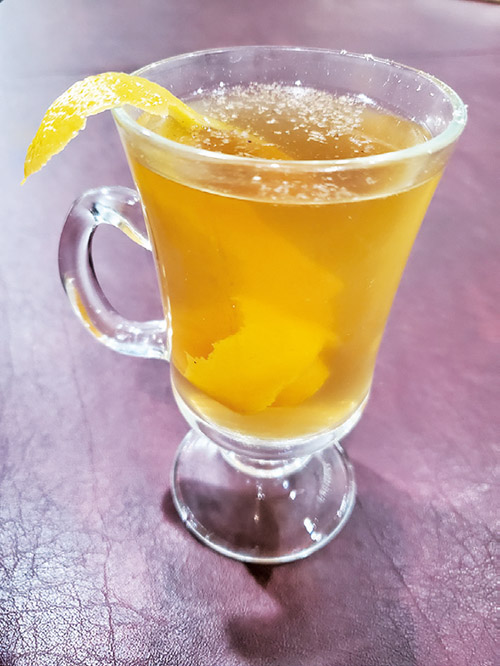
It’s wintertime and the weather is freezing. Interminable weeks of cold and snow can have even the hardiest among us feeling down (particularly when walking home from hashkama minyan when it is 18 degrees and windy outside). At times like this my thoughts turn to that most delightful of pick-me-ups, the hot toddy.
There is something so very soothing about drinking a hot toddy when coming out of cold weather. Perhaps it’s the way that a hot cocktail can make one feel warm from the inside out, or perhaps it’s because the drink’s alcoholic steam, if only momentarily, can really open up and warm the sinuses. While a hot toddy may not be as effective a gloom-lifter as a week in Miami, it is far more affordable, requires only a modicum of effort to make, and should put a smile on any frosty-cold face.
The term “hot toddy” today can today refer to any hot cocktail, but the hot toddy I always long for is something close to the toddy’s 18th century Celtic roots. A good toddy should be made with malt whiskey, whether Scotch or Irish. While a toddy made with bourbon or rye can be enjoyable, it just doesn’t have the richness and body of the original.
There were no written recipes for the first toddies, and in different lands similar drinks were known by different names. Brits had toddies; Irishmen had skins’ and Americans had slings. In 1862, when Jerry Thomas wrote the world’s first cocktail guide, “How to Mix Drinks or the Bon Vivant’s Companion,” he created distinctions between these terms. In Thomas’ nomenclature a hot toddy is booze with sugar and hot water; a sling is a toddy with a little nutmeg on top; a skin is a toddy without sugar but with the addition of lemon peel; and whiskey punch has both the zest and sugar. (Thomas’s book also has recipes for cold versions of most of these drinks.)
The recipe that follows is based on Thomas’ recipe for Scotch Whisky Punch—yes, I know it’s not “really” a toddy. The recipe will work just as well with Irish whiskey. I have altered the technique by making a sherbet (a citrus and sugar concentrate) that can then be added to individual portions, instead of making a bowl of 12 servings.
2 lemons
¼ cup of demerara sugar (use turbinado if you can’t find the demerara)
Scotch or Irish whiskey—I agree with Thomas’ recommendation of Glenlivet (I think any rich Speyside would work) or Islay. If you prefer Irish, think something malty like Redbreast or Green Spot (or a more affordable malty blend like Black Bush).
Boiling water
Nutmeg (optional)
To make the sherbet:
Using a sharp vegetable peeler, peel the zest off of the lemons, being careful to avoid removing any of the white pith. Put the zest and the peels into a one-pint mason jar, shake well, store at room temperature overnight. In the morning you will find that the sugar has extracted the essential oil from the zest. Add ½ cup of boiling water and shake well to finish dissolving the sugar. This mixture is the sherbet, and if stored in a refrigerator, will stay for about a week.
To make the toddy:
Fill a small mug or heat-proof glass with boiling water to heat the mug, then pour out the water. Add 1 Tbsp. of sherbet (you mainly want the liquid but a bit of peel is OK, too), ¼ cup of whisky and ½ cup of boiling water. Stir. Topping it with a grating of nutmeg is a nice (but optional) touch. A long strip of lemon peel from the sherbet can make a good garnish.
If you prefer a bowl of punch instead of individual toddies, make the sherbet, then pour it into a small crockpot or chafing dish. Add a 750 ml bottle of whiskey, and 4 cups of boiling water. Stir well and (optionally) grate about ¼ of a nutmeg on top. Serves 12.
A note on drinkware: I find it best to prepare hot toddies in those small, footed, glass mugs known as either London Dock glasses or hot toddy glasses. The clear glass allows one to appreciate the color as well as the flavor of the drink. Earthenware mugs and teacups will also, of course, work.
Gamliel Kronemer has been writing for more than 15 years about kosher wine, spirits, cocktails and food in a number of different Jewish newspapers and magazines. He is a contributor to The Jewish Link Wine Guide, set to be released in early April before Pesach.










